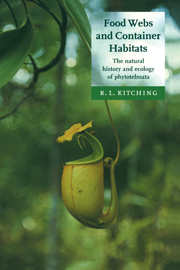Book contents
- Frontmatter
- Contents
- Preface
- 1 Introduction
- Part I The container flora, fauna and environment
- Part II Methods and theories
- Part III Patterns in phytotelm food webs
- 7 Food-web variation across geographical regions
- 8 Food-web variation within a continent: the communities of tree holes from Tasmania to Cape Tribulation
- 9 Food-web variation at smaller spatial scales: regional and local variation in tree-hole and Nepenthes webs
- 10 The role of the host plant
- 11 Variation through time: seasonality, invasion and reassembly, succession
- Part IV Processes structuring food webs
- Part V Synthesis
- Annexe: The phytotelm bestiary
- References
- Index
9 - Food-web variation at smaller spatial scales: regional and local variation in tree-hole and Nepenthes webs
Spatial pattern: smaller scales
Published online by Cambridge University Press: 26 August 2009
- Frontmatter
- Contents
- Preface
- 1 Introduction
- Part I The container flora, fauna and environment
- Part II Methods and theories
- Part III Patterns in phytotelm food webs
- 7 Food-web variation across geographical regions
- 8 Food-web variation within a continent: the communities of tree holes from Tasmania to Cape Tribulation
- 9 Food-web variation at smaller spatial scales: regional and local variation in tree-hole and Nepenthes webs
- 10 The role of the host plant
- 11 Variation through time: seasonality, invasion and reassembly, succession
- Part IV Processes structuring food webs
- Part V Synthesis
- Annexe: The phytotelm bestiary
- References
- Index
Summary
Entomologists are well aware of the place-to-place variation in occurrence of the insects they choose to study. As has been discussed in the two preceding chapters, sometimes this variation is on a macro scale: it is unlikely to be profitable to search for Toxorhynchites mosquitoes in tree holes in western Europe, or members of the chironomid genus Metriocnemus in Australia for example – these genera and the groups to which they belong just do not occur in these geographical regions as far as we know. Even within their ranges, however, particular species are not uniformly distributed. Seeking a particular butterfly, for instance, the experienced collector will generally seek out known sites – often very specific patches of habitat subsumed within the wide geographical range of the species concerned. But even at these ‘known’ sites the quarry may not be found on or around the same bush that it was found on last season: it may even be absent from the site altogether for more or less extended periods. These familiar reflections on the frustrations of the collector are a clear indication that there is population variation at spatial scales far smaller than the continental or global scales addressed in the two preceding chapters.
Just as with the highly collectible butterflies, so phytotelm organisms show comparable, more or less unpredictable patterns of occurrence within their larger biological ranges and, taken together, these produce emergent properties in the food webs of which these species are integral parts.
Information
- Type
- Chapter
- Information
- Food Webs and Container HabitatsThe Natural History and Ecology of Phytotelmata, pp. 195 - 218Publisher: Cambridge University PressPrint publication year: 2000
